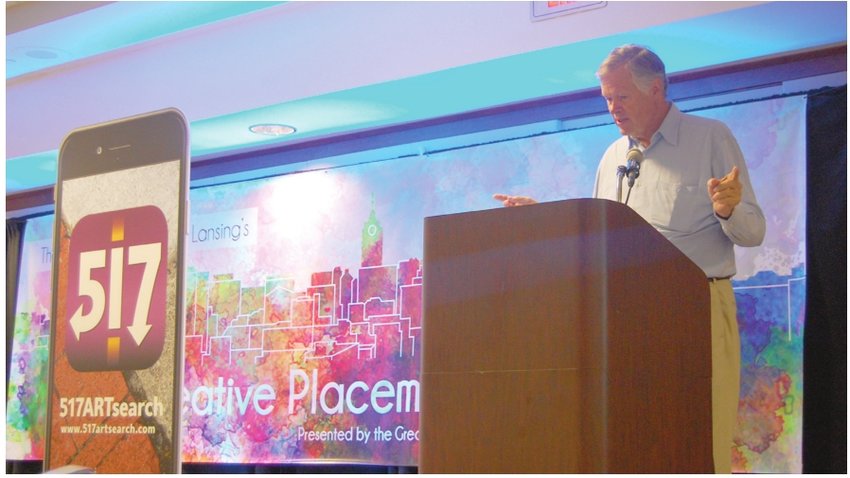
The gathering, organized by the Arts Council of Greater Lansing, was the inaugural Creative Placemaking Summit. The event was a chance for the area’s community leaders to share ideas, dreams and strategies for improving local communities.
The idea of placemaking, first developed in the 1970s, is a multi-faceted approach to the planning and design of public spaces. At its core, placemaking tries to tap into the personality of the local community to create lively neighborhoods and community spaces. This approach can include anything from urban planning and architecture to public art and landscaping.
Over 150 Greater Lansing stakeholders attended the one-day summit. Attendees ranged from public officials and community organizers to business owners and performing arts organizations. East Lansing Mayor Nathan Triplett, one of the afternoon speakers, explained that his city’s dedication to the arts is more than just a token nod to artists.
“It’s more than a pretty picture or a plaza plop,” Triplett said. “There’s an economic value.”
He cited Chicago’s “Cloud Gate” — colloquially known as “the Bean” — as an example of public art driving tourism. A trip to Chicago is hardly complete, it seems, without a selfie in front of the giant mirrored sculpture.
Triplett used Imran Qureshi’s “Fragmented” as a local example of what can happen when public servants get out of the way. During the artist’s residency at MSU’s Broad Art Museum, Qureshi ventured into East Lansing to create eye-catching, blood-red splatter paintings on the city’s sidewalks. Triplett said the City Council recognized the chance to work with a world-class artist.
“We didn’t ask him to go through a process,” Triplett said. “We thought this was a great opportunity to do something special. I think it was a great success.”
The wide-ranging slate of speakers also included such community activists as Vincent Delgado, assistant dean for civic engagement at MSU’s Residential College in the Arts and Humanities, Joan Nelson, executive director of the Allen Neighborhood Center, and Ryan Wert, president of the REO Town Commercial Association.
Discussions and presentations ranged from attempts to revitalize Michigan Avenue and the impact of public art to practical concerns like statewide funding opportunities and creating better transportation networks.
“People left feeling inspired, feeling like they want to take action” said Josh Holliday, Arts Council or Greater Lansing program manager and organizer of the summit. “We’ve had an overwhelmingly positive response.”
The event’s keynote speaker, Fred Kent, laid out his prescription for placemaking in an afternoon session.
“We don’t believe in master plans,” he said. “We believe in community-led vision. It’s about the soul of the community.”
Kent is the founder of the nonprofit Project for Public Spaces. Since its inception in 1975, the group has facilitated placemaking projects in all 50 states and 43 countries. Among the group’s most successful projects are the transformation of Detroit’s Eastern Market and Campus Martius.
Lansing’s biggest hurdle, Kent said, stems from its role in automotive history.
“Your streets are offensive,” he said.
“You’ve done well at building capacity for cars, but have not done well at building capacity for people.”
Kent also emphasized a “quicker, lighter, cheaper” approach to placemaking, starting with easy, community-led solutions and building to larger permanent projects.
Holliday thought that attendees left the summit energized by the chance to learn more about placemaking concepts.
“People are feeling more educated, more inspired,” he said. “They feel a sense of urgency.”
At the conclusion of the summit, attendees were invited to walk down to the corner of Michigan Avenue and Cedar Street for the unveiling of “Greetings from Lansing,” a new 12-by-28-foot mural overlooking the intersection. The project was spearheaded by Downtown Lansing Inc. with funding from the Lansing Economic Area Partnership. Bob Trezise, LEAP’s president and CEO, explained how placemaking and public art contribute to the city’s economic viability.
“The number one issue people are talking to LEAP about is that they are competing for workers on an international scale,” Trezise said. “We need to have a great place that is competitive with bigger cities.”
Support City Pulse - Donate Today!
Comments
No comments on this item Please log in to comment by clicking here